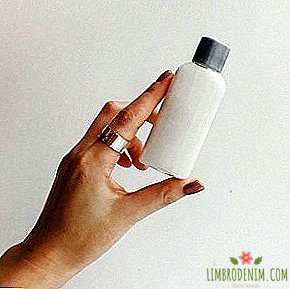The Ideal Couple: How do drugs and pop culture relate
In April, 21-year-old rapper Lil Xan released the debut album "Total Xanarchy", which entered the Billboard 200 rating, and included the musician in the top 10 newcomers. Who would have believed that the guy who took the abbreviation from the name of tranquilizer as a pseudonym would become something other than a meme. The release of Lil Xan came out successful, but now it is difficult to estimate, for which the rapper fell in love more - for the music or the love of sedatives. He managed to defiantly reject the latter after the death of the musician Lil Peep - she had an overdose of potent opioid fentanyl and tranquilizer alprazolam. We understand what caused the fashion for substances, how it was covered by pop culture and why drug propaganda does not exist.
not recommended for readers under 18

Heroin and Club 27

It is known that heroin popularity in the United States increased significantly after the Second World War and the Vietnam War, but the era of Prohibition (started in 1920 and lasting thirteen years) shaped it as a pop cultural phenomenon. Cannabis, cocaine and, of course, heroin were very popular in underground bars. At the same time came the heyday of jazz. He played in brothels and underground clubs in New Orleans, Chicago and New York Harlem - the owners and staff were often associated with organized crime or filled with drug trafficking, and the musicians became their regular customers.
A British culturologist Andrew Blake, in his article “Drugs and Popular Culture in Modernity,” says that there was an analogue of the myth of Faust in music circles: as if Robert Johnson, the legendary bluesman, met the devil at a quiet intersection in Mississippi, sold his soul and therefore played best of all (by the way, Johnson is considered the first member of "Club 27" - these are musicians who died at the age of 27). Another legendary character was jazz saxophonist Charlie Parker - in addition to his unique skill, he was also known for his heavy heroin addiction.
Legends about the miraculous effects of heroin on creativity went far beyond the US - according to Blake, British white musicians used heroin, hoping to catch up with brilliant African Americans. They romanticized death: the executor in this system of coordinates seemed to be paying for talent for drug addiction and early departure from life.

Blake believes that the aesthetic idealization of the clandestine clubs and the lifestyle of the African Americans who spoke there partly influenced the attitude towards heroin. White beatniks, in his words, were addicted to heroin, including because of their interest in jazz and black jazzmen. American publicist and writer Norman Mailer also talks about imitating black culture: the new white American, from a sense of non-conformism, copies the manners and lifestyle of African Americans from dangerous areas, sabotaging traditional rules and trying to get more and more forbidden pleasures.
The penetration of heroin from African-American areas into the life of bohemian white youth is recorded by William Burroughs novel "Junk", which describes in detail experiments on the use of opioids. At the same time, heroin is just one of the drugs in which the beatniks, known for their great energy and curiosity, were interested. They were supported by a rather invigorating amphetamine, rather than intoxicating opioids.
Heroin remained at the zenith of glory until the sensational appearance of psychedelics and returned in the 70s-90s in a different capacity - as a symbol of the dramatic finale and the “last frontier”. At this time, heroin was finally classified as a class of drugs that are not used for entertainment. Pop culture - from the frightening tape "We are children from Zoo station (I am Christina)", where David Bowie was invited, to the perky movie "On the needle" and Hubert Selby's book "The Last Turn on Brooklyn" - explored heroin as a tragic dependency and It seemed to put an end to opioids.
Opioid return

In the past few years, the United States and Canada faced a new opioid epidemic, not among young fashionistas or people from poor areas, but among wealthy middle-aged Americans. According to statistics, the latter die of overdoses more often than members of any other social group. The opioid epidemic is a consequence of the boom of pain relief in the 90s: pharmaceutical companies advertised opioids to eliminate all types of pain, arguing that the drugs are not dangerous and do not cause dependence (since then, customers have filled up pharmacists with lawsuits).
Opioids have returned to pop culture, now in the form of pharmacy names - is it worth reminding how Dr. House loves them? Migos, Future, SchoolBoy Q and Eminem rappers often mention opioid pain medications with oxycodone. Codeine syrup is also popular - Young Thug, Gucci Mane and Lil Wayne are read about it. In the US, it is called the elegant "Lean", "purple" or simply "syrup" (at one time codeine cough syrup was easy to buy in Russia, which, of course, many used).
It is obvious that the pop culture only responded to the opioid epidemic, and not provoked it. In this sense, an overdose of Lil Peep is indicative: while the rapper spoke in social networks about the love of a socially acceptable tranquilizer, almost no one knew about his dependence on toxic fentanyl.

Acid rock

The 60s for the USA and Western Europe became a unique time of the flourishing of left activism: young people opposed conservatism, raising feminism, ecology, pacifism and sexual liberation to the shield. In the 60s, against the backdrop of the dream of a new society, LSD became particularly popular.
Unlike opioids, LSD was synthesized relatively late - in 1938 - and until the mid-sixties, the substance was used either in closed experiments (the drug was actively tested by the FBI) or in private practice: the new medicine was popular among expensive psychotherapists and Hollywood bohemians. Soon, LSD became mainstream - the efforts of enthusiasts who considered it their duty to introduce as many people as possible to the substance.

Harvard employees Timothy Leary and Richard Alpert tested LSD on student volunteers (their experiments were later found illegal). And Ken Kesey, the author of the famous novel "One Flew Over the Cuckoo's Nest", impressed with the experiments of the special services, organized the community of Merry Pranksters with friends, which conducted the famous "acid tests" and distributed LSD to everyone. According to the plan of the main adherents of the movement, LSD, ideally, should be absolutely free: The Brotherhood of Eternal Love, which stood at the origins of the hippie, dreamed of accelerating the pace of drug production so that it would completely depreciate.
LSD has become an integral part of the political program of the youth of the 60s, and also changed the perception of music and culture in general. The first representatives of acid-rock (Grateful Dead, The Doors and Pink Floyd are usually attributed to it - their performances were compared with acid trips) offered their listeners a completely new experience: in order to understand and feel their music to the end, it was not only wearing headphones but also change the mind.
MDMA and EDM

The approach, in which music is inseparable from narcotic experience, ideally embodied in the culture of raves. If acid rock could still be heard at home, then acid house appeared in the late 80s and was an exceptionally big party with MDMA. Even its tempo speaks about it: if earlier the standard speed of music was 60 beats per minute - the ordinary heart rate, then with the advent of acid house it doubled exactly. Music critic Simon Reynolds, in his book Ecstasy Generation: In the World of Techno and Rave Culture, wrote that dance music very soon began to consciously enhance the effect of MDMA.
In the late 80s, the substance appeared at parties: researchers from Ivy League universities (former like-minded Timothy Leary) offered their visitors to try MDMA instead of cocaine - they thought the substance was safer and certainly cheaper. Acid House and MDMA were so well suited to each other that the years 1988-1989 were called “the second summer of love”. However, the summer finally became obsolete by the mid-90s. The Brit-pop came to replace the acid house, and Ecstasy replaced alcohol.
The second big wave of MDMA popularity occurred in the early 2010s, during the rise of electronic music. Ecstasy seemed to change the audience: if before it was playfully called “Garry” (in the UK) or “Adam” (in the gay clubs in Dallas), then ecstasy entered the new millennium under the girl’s name “Molly”. In 2012, Kanye West, Miley Cyrus, Nicky Minaj and Rick Ross talked about her. By the way, the latter had to apologize for a line about sex without consent under ecstasy: “I added Molly to her champagne, she didn’t know about it. Took her home and had sex with her, she didn’t know about it”. Madonna, coming to the crowd at the Ultra Music Festival - 2012, asked: "Who saw Molly today?"
MDMA is associated with pop culture to a greater extent than other drugs, and the schedule of its popularity almost coincided with the musical trends and formats of parties. Yet the drug only catalyzed the desire of people to get together at big parties.

Crack and cocaine

"Benzedrine (a trade name of amphetamine that no longer exists. - Approx. Ed.) - that will help me keep my sanity today. Perhaps he will make me too self-confident, but it will also help, "said James Bond in Lunar Racer, stirring the substance in his champagne. Ideologically, stimulants are on the opposite pole from LSD and ecstasy: if hallucinogens and eiphoretics suggested" enlightenment "and" love ", then stimulants were used, for example, in the army for greater executiveness and efficiency.
At the 70s and 80s, the United States reached the peak of the popularity of cocaine, which is ironically called “amphetamine for the rich” (although cocaine has a much more pronounced effect on the emotional state). As the Colombian drug lord Pablo Escobar seized the American drug market, cocaine became increasingly in demand among celebrities and simply rich people. “Coke is so expensive that when it comes to buying it, Hollywood stars turn into Scroogey McDuck,” said a Hollywood spokesman Michael Maslansky in 1978. And in an interview with the New York Times in 1982, the psychopharmacologist Ronald Siegel, who worked for one Hollywood rehab, noted that celebrities are willing to spend a million dollars a year on cocaine. Cocaine is still considered a drug for celebrities: it was also used by porn stars of the 70s in Paul Thomas Anderson's Boogie Nights, and young teenagers from Hollywood in David Cronenberg's Star Card. A reference to the drug in popular music is not worth it and try to count.

Cocaine was also used on stock exchanges: one of the foreign traders linked its popularity with the ability to replace sleep with a drug, and dramatic stories about white powder traders' hobby are still very popular with readers of the business press. The connection of cocaine with yuppie culture and big money is thoroughly reflected in pop culture. From the recent "Wolf of Wall Street" (from the filming of which John Hill was taken to the hospital with bronchitis because he sniffed too much crushed vitamin D - fake cocaine) and "American psychopath" (among other things, the main character works on Wall Street and loves cocaine) to Scarface and Cocaine by Ted Demme. The drug broadcast a successful lifestyle for those who were sitting in an office in Manhattan, and for those who tried to cash in on drug traffic.
"The popularity of cocaine reached its peak by 1985. Then it only declined, including because of the crack cocaine epidemic. The social status of the drug depends on who uses it. Since then, sitting on cocaine meant that you are not the hedge fund manager and cheap stuff, "believes Mark Clayman, one of the top US drug policy experts. According to statistics, in the mid-80s one of seven graduates of American schools tried cocaine, by 2009 this figure had dropped to one out of twenty.
The emergence of crack - a crystalline form of the drug mixed with soda, which was several times cheaper than the luxurious original - led to the high price and popularity of cocaine. The sale of crack and the status of a drug dealer at the same time became associated with immigrants from poor areas with the opportunity to earn and emancipate. On the sale of drugs as a way to achieve success reads, for example, Pusha T in the track "Clipse-Grinfdin '" (at first he gets rich by selling crack, and then he admits that cocaine is an indispensable companion of wealth), and Fetty Wap in "Trap Queen" tells as he and his girlfriend prepare crack for sale. To sell crack in this coordinate system means to break through from the bottom, and cocaine symbolizes the highest point of success, along with diamonds, cars and expensive clothes.
Drugs for success

If the crack epidemic has more affected the poor areas of the United States, then psychostimulants, like the new opioid wave, owe their growing popularity to neat medical offices. From 2003 to 2011, the number of children with attention deficit hyperactivity disorder (ADHD) in the United States increased by 43%, and by 2015 the local psychostimulant industry, which was prescribed for ADHD, was estimated at $ 13 billion. According to forecasts, by 2020 it can grow to 17 billion.
Prescription psychostimulants act differently on people with and without ADHD. If simplified, they first help calm down, have a stimulating effect on the second, making them noticeably more workable. Drugs of this type have replaced amphetamine and have become a full-fledged part of the culture of overproductiveness. Prescription psychostimulants are believed to be very popular among the millennials (they are sometimes ironically called the “adderol generation” - a mixture of amphetamine salts).
Unlike LSD, used by students of the 60s, or MDMA, created for parties, psychostimulants were not intended to be fun. They were considered a means for successful work or study. On prescription psychostimulants almost no rap and sing songs, but there are links to them in many TV shows - from "Griffin", where one of the heroes Brian using psychostimulant writes a novel to impress writer George Martin, to "South Park", where the problem of prescription drugs for children is raised, and, of course, in the series Silicon Valley, where the main character Richard is trying to buy a psychostimulant from schoolchildren on the street. The “generation of adderol”, in fact, re-invented the meaning of drugs: the famous experiments with microdosing of LSD in Silicon Valley were obviously not carried out to fight capitalism, but in the name of it.

Red Devil

“Eat him because you heard about him in the song,” reads rapper Isaiah Rashed, referring to the tranquilisators, the dependence on which he barely overcame himself and joined their opponents. In the epidemic of alprazolam, it is customary to blame sad rappers, but its popularity is a much more complicated phenomenon than the consequences of the new sad album, Princess Nokia.
Sedative prescription drugs for a long time were prescribed mainly to women - this is how the image of a depressed housewife was formed, which constantly needs medical help. "In culture, there was a so-called depressive role, it supported the idea of the difference between men and women," said psychiatrist and author of "How Everyone Became Depressive." With equal symptoms and analyzes with men, women are still twice as likely to diagnose depression and prescribe medication.
First, the women were prescribed morphine (and women were among the first to be dependent on prescription drugs), then barbiturates. In the 50s, "little mother's helpers" appeared - tranquilizers - and finally antidepressants. The latter have become so popular that, according to 2013, 25% of Americans between the ages of 40 and 50 use serotonin reuptake inhibitors. In general, the name of the film "Prozac Nation" is not such a metaphor.

Gender boundaries have begun to fade over time, but the consumption of antidepressants and tranquilizers is only growing: now they are popular not only as prescription drugs, but also as tablets that they buy on darknet or from street dealers. They have noticeable advantages over the same antidepressants: they act immediately, they do not reduce libido, they do not have to be used regularly. At the same time, tolerance to benzodiazepines is produced very quickly, so that their use can lead to a permanent increase in the dose and, in rare cases, to an overdose.
There is a lot of talk about the epidemic of tranquilizers in the UK, where these drugs are rarely used in medical practice, but 22% of sales of darknet tablets are in the United Kingdom. Part of the drugs sold is produced underground: for example, The Red Devil appeared - a tablet containing two and a half times more alprazolam than the usual bar of a legal drug.
The popularity of a tranquilizer, in whose honor Lil Xan called himself, was influenced by the boom of prescription drugs, the prevalence of depressive conditions in young people, and the general medicalization of life. The spread of potent tranquilizers is also a logical consequence and a reverse side of the recent spread of psychostimulants. Почему именно этот препарат стал знаковым для современной поп-культуры? Она всего лишь отражает мироустройство, в котором одиночества больше, чем коллективного действия. Чтобы послушать музыку наедине с собой, эйфоретики не нужны.
Photo: Getty Images (2), Wikimedia Commons (1, 2), Channel Four Films, New Line Cinema, Universal Pictures, LIL XAN/Facebook




